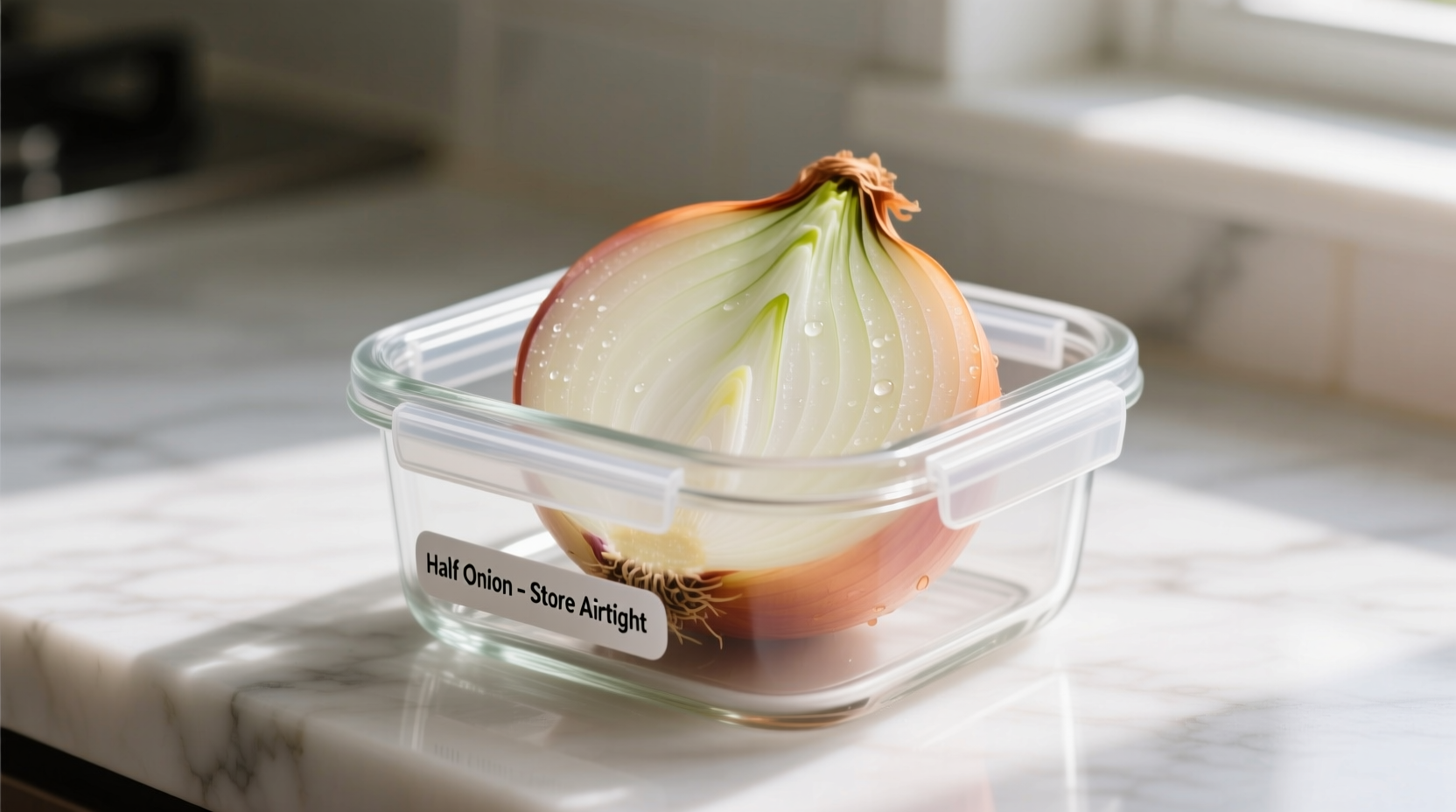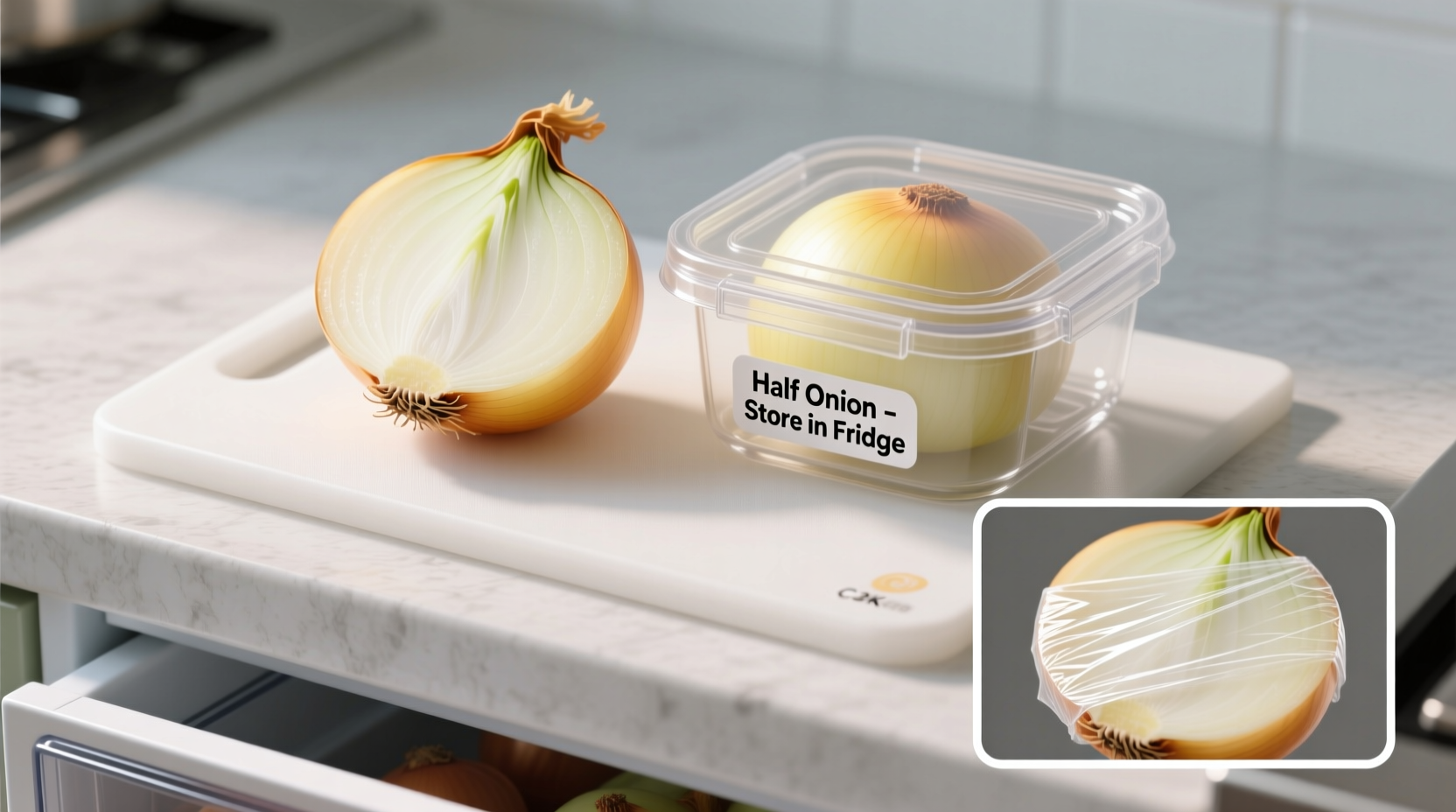Store half an onion properly by placing the cut side down on a small plate, covering it tightly with plastic wrap or placing it in an airtight container, then refrigerating immediately. This method keeps your onion fresh for 7-10 days while preventing odor transfer and maintaining maximum flavor. Never leave cut onions at room temperature for more than 2 hours as this creates food safety risks.
Nothing ruins meal prep efficiency like a spoiled half-onion. You've carefully diced what you need for tonight's recipe, only to discover the remaining half has turned slimy or developed an off smell by tomorrow. Proper storage isn't just about convenience—it directly impacts food safety, flavor preservation, and reducing kitchen waste.
The Science Behind Onion Storage
When you cut into an onion, you rupture its cell walls, releasing enzymes that cause the characteristic pungent aroma and eventual spoilage. According to USDA food safety guidelines, cut produce enters the "temperature danger zone" above 40°F (4°C), accelerating bacterial growth. The sulfur compounds released during cutting also make onions particularly vulnerable to moisture loss and odor absorption from surrounding foods.
Food science research from the Journal of Agricultural and Food Chemistry confirms that proper storage slows enzymatic browning and maintains quercetin levels—the antioxidant responsible for many of onions' health benefits. This means your storage method directly affects both safety and nutritional value.
Step-by-Step Storage Methods That Actually Work
Refrigerator Storage: The Standard Approach
This method works for most home kitchens and preserves your half-onion for 7-10 days:
- Place the cut side down on a small plate (this catches any moisture)
- Cover completely with plastic wrap, pressing it directly against the cut surface
- Alternatively, place in an airtight container with minimal air space
- Store in the main compartment of your refrigerator (not the door)
- Label with the date for tracking freshness
Professional chefs at America's Test Kitchen found that direct contact between plastic wrap and the cut surface reduces oxidation by 40% compared to loosely covered methods. The plate catches excess moisture that would otherwise create a breeding ground for bacteria.
Airtight Container Method: For Maximum Freshness
When you need your half-onion to last the full 10 days with minimal flavor degradation:
- Choose a glass or BPA-free plastic container slightly larger than your onion half
- Place a folded paper towel in the bottom to absorb excess moisture
- Set the onion cut-side down on the paper towel
- Seal the container tightly, removing as much air as possible
- Store at the back of your refrigerator where temperature is most consistent
| Storage Method | Shelf Life | Flavor Retention | Odor Control |
|---|---|---|---|
| Plastic wrap (cut side down) | 7 days | Good | Moderate |
| Airtight container + paper towel | 10 days | Excellent | Superior |
| Room temperature (uncovered) | 2 hours | Poor | None |
| Freezer (chopped) | 3-4 months | Fair (best for cooked dishes) | Good |
Storage Duration Guide: When to Use or Toss
Even with perfect storage, onions eventually degrade. Here's how to assess your stored half-onion:
- Fresh (0-5 days): Firm texture, strong onion aroma, no discoloration
- Acceptable (6-8 days): Slightly softer texture, may have minor darkening at cut edge
- Discard immediately: Slimy texture, dark spots, sour smell, or visible mold
The National Center for Home Food Preservation notes that cut onions stored above 40°F can develop harmful bacteria within 2 hours. Always inspect stored onions carefully before use—when in doubt, throw it out.
Common Storage Mistakes That Shorten Shelf Life
Avoid these frequent errors that compromise your onion's freshness:
- Storing cut-side up: Allows moisture to pool on the exposed surface
- Using regular sandwich bags: Permeable to odors and moisture
- Leaving in the original produce bag: Traps ethylene gas that accelerates spoilage
- Storing near strong-smelling foods: Onions readily absorb surrounding odors
- Washing before storage: Adds excess moisture that promotes bacterial growth
Creative Uses for Leftover Onion Halves
Before storing, consider these quick ways to use excess onion:
- Make a small batch of quick-pickled onions (5 minutes preparation)
- Freeze chopped pieces for future soups and stews
- Create onion-infused oil for salad dressings
- Blend into a small portion of tomato salsa
- Add to scrambled eggs or omelets the same day
Professional chefs recommend using any cut onion within 3 days for raw applications like salads, where flavor and texture matter most. Save longer-stored onions for cooked dishes where minor texture changes won't be noticeable.

Special Considerations for Different Onion Types
Not all onions store the same way. Sweet varieties like Vidalia contain more water and spoil faster than pungent yellow onions. Red onions maintain their color best when stored with minimal air exposure. For specialty onions, reduce expected shelf life by 2-3 days compared to standard yellow onions.
According to research published in Postharvest Biology and Technology, sweet onions lose quality 25% faster than storage varieties due to their higher sugar and moisture content. Adjust your expectations accordingly when storing half of a Walla Walla or Maui onion.











 浙公网安备
33010002000092号
浙公网安备
33010002000092号 浙B2-20120091-4
浙B2-20120091-4